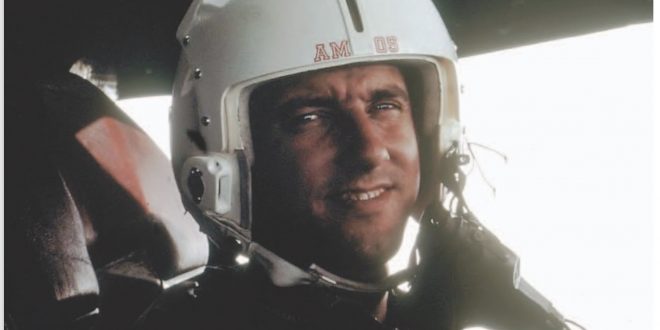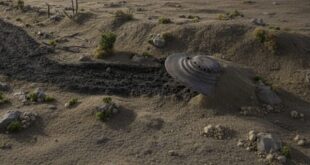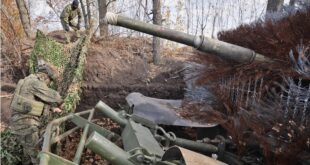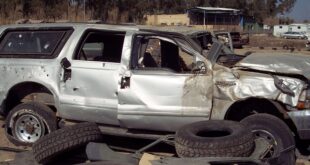JIMMY STEWART FLEW IN VIETNAM? WHAT MOVIE WAS THAT !!
© J David Truby 2018
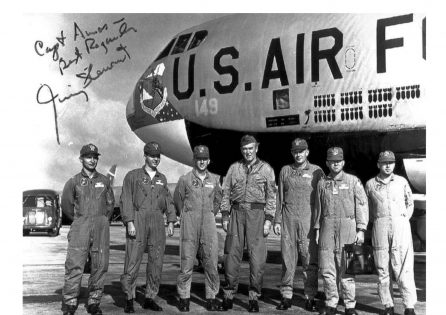
Guam, Feb 1966. A B-52 back from a highly classified Arc Lite bombing run over Vietnam was headed in for what was supposed to be a routine landing. The crew had done so dozens of times without incident. So, this time should be no different, right? However, when Capt. Bob Amos heard his co-pilot, Capt. Lee Myers, exclaim nervously, “The flaps are splitting!” Amos’s heart dropped. There’s nothing worse than being responsible for the wreck of your bomber back on home base, the damage to your crew, and, oh, yeah….. for the death of a internationally famous decorated American war hero and a Hollywood legend….their very highly classified passenger.
By J. David Truby, PhD as it appeared in the FLIGHT JOURNAL magazine.
Jimmy Stewart was their secret passenger on that flight! Yup, that Jimmy Stewart.
Immediately, Amos ordered the the flaps pulled out and up, declaring a major emergency.
Why was 58 year old Jimmy Stewart even in Vietnam and on that flight ?
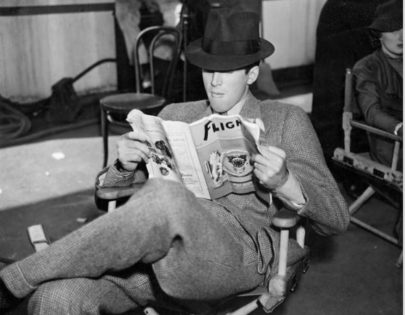
James Maitland Stewart didn’t always aspire to be a successful actor. Growing up in Indiana, PA, a small rural town with its own small rural grass trip airport, young Jimmy Stewart took a keen interest in aviation. But, it wasn’t until he graduated from Princeton University and became an MGM contract player that the actor began to pursue his love of aeronautics. In 1935, Stewart obtained his private pilot license, upgrading it to a commercial license in 1938. A movie star by then, he owned a Stinson 105, which he used to fly home, CA to PA, to visit his parentsquite often.
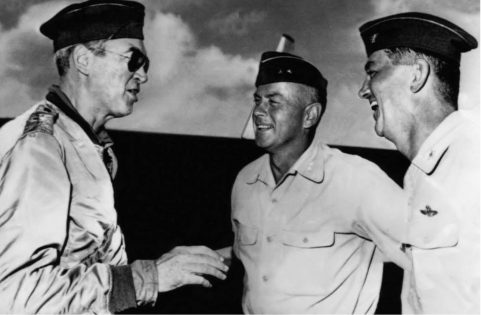
The 6’3”, 138-pound actor was drafted, then rejected due to his inability to meet the WWII weight requirements. However, due to his strong sense of duty and his wish to carry on his family’s military tradition, Stewart almost made the weight, but, the Army cut him their break and enlisted him as a private in the U.S. Army in March 1941, weeks after winning the Academy Award for Best Actor in “The Philadelphia Story” and nine months prior to the attack on Pearl Harbor. He went to flight school immediately.
Due to his education and flight experience, Stewart was commissioned as a second lieutenant and became a U S Army Air Corps flight instructor. Rising through the ranks, his celebrity status and the power of MGM relegated him stateside to “safe” assignments. But, using his own rep and some “Up The chain HQ” contacts, Captain Stewart became operations officer of the 703rd Bombardment Squadron, 445th Bombardment Group, flying B-24s over Europe from England.
Within three weeks, he was promoted to commanding officer and flew his first combat mission in December 1943. By the end of a successful WWII career, Stewart earned the rank of major, as well as many awards, including multiple Distinguished Flying Crosses and the Croixde Guerre avec Palme presented to him by France.
His WWII career was not all the glossy glamour offered by the media and Hollywood. The most honest account of Jimmy Stewart’s WWII heroic and scary PTSD experience, known then as Battle Fatigue, is the crux of Robert Matzen’s truly superb book, MISSION: JIMMY STEWART AND THE FIGHT FOR EUROPE.
Post-WWII saw Stewart retiring from active duty, but he remained in U.S Air Corps as a reserve officer where he was promoted to brigadier general and commanded Dobbins Air Reserve Base in Marietta, Ga. However, retirement did not tame the adventurous spirit of the aging actor who quietly requested to visit Vietnam for an “Active Duty Reserve Tour.”
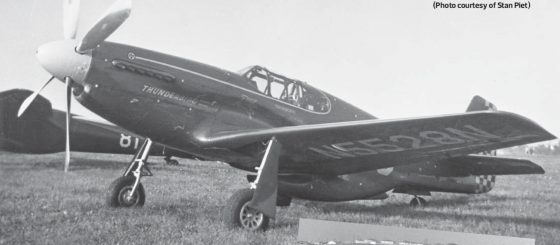
It had been 22 years since he earned his first Distinguished Flying Cross in 1944 for leading B-24 missions over Germany. His purpose for flying to Vietnam was to boost Air Force morale. But, this brave and confident combat veteran could not sit idly by and boost by words alone. Through his career as a reserve officer, Stewart had qualified as a lead Strategic Air Command (SAC) bomber pilot in the B-36, the B-47, and the B-52.
As he was qualified to fly the B-52 and wanted to fly on an active bombing mission to observe how the younger pilots and their crews were handling themselves in the Vietnam war which was very different than the one in which Stewart earned his deserved reputation…and so he did..
Arriving at the Andersen Air Force Base in Guam in February 1966, Stewart wasscheduled for an Arc Light bombing run. Operation Arc Light was the deployment of B-52s to provide close air support mass bombings of enemy base camps, supply lines and troop concentrations. Stewart’s crew’s objective was to strike active Viet Cong units in South Vietnam. However, his being on this specific mission was kept a secret from press and crew alike. It was kept classified due to fear that if leaked, the intelligence would allow for very concentrated, specific enemy interception. The Soviets and the North Vietnamese openly offered $$$ rewards for the death or capture of American celebrities during the war. The crew’s prior knowledge could’ve rattled the nerves of the soldiers already concerned about anti-aircraft fire, including reportedly newer model soviet AA rockets, plus MiG fighters.
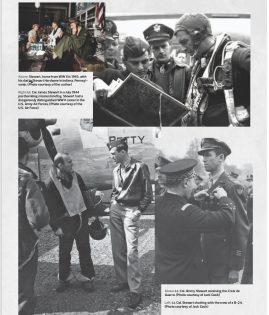
For sure, pre-flight news of Jimmy Stewart aboard would have attracted that deadly enemy attention.
On February 20, 1966, Capt. Bob Amos, of the 763th Bombardment Squadron, 454thBombardment Wing, 3rd Air Division, was prepping for his mission the following day. Checking his flight schedule, he was surprised to see “Brigadier General Stewart” as a part of his crew. Questioning his squadron commander, Amos was surprised by his response.
“You know, Bob, it’s Brig. Gen. Jimmy Stewart, the actor!”
Amos was excited to tell the men on his crew. Capt. Lee Meyers, Capt. Irby Terrell, Capt. Kenny Rahn and Tech. Sergeant Demp Johnson, along with Amos, were a seasoned lead crew with over 20 successful combat missions under their wings. This young crew was anxious to show the elder statesman Stewart what the new guard was made of.
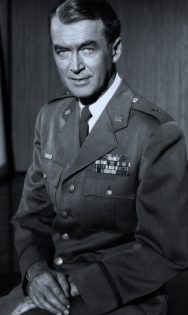
After the mission briefing, Capt Amos felt confident the sortie would go according to plan. On February 21st, Tech. Sgt. Johnson brought fresh eggs, bacon, bread and cheese for the long flight that was expected to last up to 13 hours. The six-man crew, including Stewart, rode in Green-2, the second aircraft in the 30-airplane bomber stream. It was a textbook flight. The checklists were completed. The engines roared to life. The mid-air refueling was spot on. Despite the crew’s anxiety of having Stewart’s life in their hands, the mission was as flawless as it could get.
Sitting in the instructor pilot seat, Stewart was highly impressed by the goings on around him. When they approached the coast of South Vietnam, Stewart moved to the edge of his seat to get a better view of the bomb impacts of the aircraft ahead of them. At 33,500 feet, Green-2’s “Time to Go” indicator started the countdown. At zero, 51 M-117, 750-pound bombs began their descent, all landing successfully within the desired Circular Error of Probability.
With the mission completed successfully and the B-52s safely out of Vietnamese airspace, the electric frying pan got plugged in and a welcomed breakfast was prepared. Enjoying his hearty provisions of fresh bacon, scrambled eggs and grilled cheese sandwiches, Stewart congratulated the famished crew on how they celebrated their successful bomb run.
“Wellll,” he drawled, “this sure is a helluva lot different from our mission returns over Germany all those years ago.”
The safe return was nearing its end, when approaching Guam airspace, when the co-pilot uttered those fateful words, “The flaps are splitting!” That meant the B-52 was headed for a total disaster. Knowing that a “flaps-up” landing might still be possible, though, Amos, nevertheless,feared the dramatically different approach of a nose-up crash landing.
An intense, emergency procedure rolled out . Asked by the 3rd Air Division commander, Maj. Gen. William J. Crumm, if the flaps were indeed split, Amos radioed, “There was a mild rolling moment to the left…could have been from the B-52 in front of us….By the time, the tail gunner got a view of the flaps, both of them were back in the up position.” Moving Stewart into position on the lower deck for the possibility of a bailout, Amos decided the flap extension should be executed again.
He told Gen Stewart, “ Sir, if I lose control of the aircraft, I will call out on the intercom ‘ BAIL OUT’ three times and activate the bailout light. The navigator will be the first to go, creating a large hole by his downward ejection seat. Do you understand, Gen. Stewart?”
“Yes, Capt. Amos, I understand,” Stewart, a veteran of many serious WWII combat flight emergencies, calmly replied.
Proceeding to the planned bail out area, the crew began to calculate the flaps-up landing data…figuring THIS IS IT!. With everyone in position for the possible bail out, Amos ordered, “Lower the flaps!”
The gauge indicted the flaps splitting, but the flaps were extending normally with no evidence of rolling. Amos radioed to the command post, “It was a bad flap gauge…we think.”
Knowing that Jimmy Stewart was aboard Green-2, the airfield was a flurry of activity. Emergency equipment and VIP staff in case of a flaps-up landing. However, there was to be no flaps-up landing that day. Touching down after 12 hours and 50 minutes in the air, the plane was greeted by the huge crowd at Andersen Field. Stewart suggested a commemorative picture of the Green-2 crew before being whisked to the “Beer Barrel,” an on-post celebratory facility just as its name implied. Meanwhile the crew attended the debriefing before also making its way to the celebration.
Before leaving the base the next day, Brig Gen Stewart requested a special audience with Capt. Amos. He thanked him and his crew for their cool and professional demeanor during their mission and in-flight emergency. It was his last combat flight, and it certainly was a mission he would never forget.
He later said, “I remembered Gen George Patton’s speech where he said ‘No man wins a war by dying for his country. He wins it by making the enemy die for his country.’ But, in real war, things are never that black and white.”
Which may have been why Vietnam was not over for Jimmy Stewart, as tragedy struck his family three years later. In June of 1969, his stepson, 24 year old USMC lst Lt Ronald McLean, was killed on an ambushed recon mission near the DMZ. It was a huge blow for the entire family and their friends.
Brig. Gen. James Stewart had retired from the U.S. Air Force in 1968. He never spoke of his classified mission in Vietnam. Capt Amos never did, either. He went on to fly 34 combat missions over Vietnam in the B-52F, and later 126 missions in F-105Ds. He retired as a Colonel in 1984.
Col Amos said only of that mission, “It was a great experience for us all and a huge honor for us to have Brig Gen. Stewart fly with us. He is truly the same modest gentleman in person as he portrayed in his many films.”
Mostly, the mission was kept a secret due to its almost deadly consequences, but also because Stewart was always a modest man. He took pride in his military achievements without flaunting them. He was a keen observer and a quiet doer. And, he never wanted to create a hassle due tohis celebrity status, especially for the crew that never saw an obstacle it couldn’t overcome, except that one time when it almost crashed with one of America’s greatest real and true icons aboard.
© J David Truby 2018
 Soldier of Fortune Magazine The Journal of Professional Adventurers
Soldier of Fortune Magazine The Journal of Professional Adventurers


